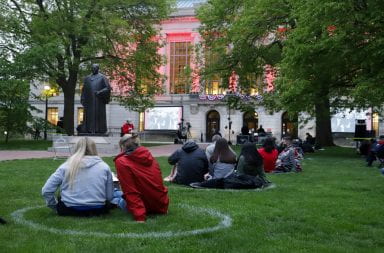For many college students, residence halls are the transition from living with their parents to being on their own.
“Residence halls are fundamentally a rite of passage,” said Steve Kremer, assistant vice president of Student Affairs at Ohio State in a presentation to the Board of Trustees Friday.
They are environments that are regulated and supervised by resident advisors who can help students adjust to being away from home, he said.
The occupancy of residence halls has grown significantly in the past few decades, with 90 percent of incoming freshmen choosing to live on campus, Kremer said.
In addition to freshmen occupying the residence halls, many more students are returning for a second year of residence-hall life, he said.
The current housing system is not at the level it needs to be to function efficiently for at least the next 20 years, Kremer said.
He said there are significant challenges such as helping students manage privacy with roommates and fitting all of their belongings comfortably into the rooms.
“Students today have a significant amount of stuff,” Kremer said. “It is hard to fit a 2005, 18-year-old lifestyle in a 1960s room.”
Officials at OSU would like to renovate the current residence hall system to help manage students’ needs for privacy but still keep a community atmosphere, he said.
“We plan to reoccupy places that were originally meant to be residence halls to reduce density (in dorms),” Kremer said.
Bill Hall, vice president for Student Affairs, said he would like to convert current family housing areas into undergraduate housing in an effort to provide additional space, as well as construct new buildings to function as residence halls.
It has been estimated during this academic year that students living in residence halls spend approximately 70 percent of their day in their dorm building sleeping, studying, or socializing, Kremer said.
He also said he has seen a significant effect on students’ academic success when they live in residence halls. He said the 45 Living-Learning Programs OSU currently supports have greatly benefited students.
Living-Learning Programs are residence areas that provide a bridge between the classroom and supplemental experiences in the residence hall, as well as providing constant academic and social support, according to the OSU Housing Web site.
Aftab Pureval, former undergraduate student government president, said he agrees that the Living-Learning Programs at OSU are strong.
“An honors living environment is a key element in recruitment (of incoming students),” Pureval said.
Pureval said other residence halls need to be renovated to increase space for students. The current facilities are small and do not offer students much personal room, which can decrease their likelihood of getting the best experience on campus they possibly can, he said.
Increased demand to live on campus can also perhaps be attributed to the proliferation of violence in off-campus areas, he said.
“There is a greater need for students to stay on campus to help them feel safe,” Pureval said.
Kremer said he would eventually like to see 2,000 more spaces available for undergraduate students on campus. He said half of those spaces would likely come from conversions of current buildings into residence halls and the other half would come from the construction of new residence halls.
Kremer could not be reached for comment about the cost of the project and where funding would be coming from.
Hall said the construction and conversion process is moving forward as rapidly as possible despite budget constraints.
In his presentation, Kremer spoke of the need for a renovation of the current residence hall system as a result of the change in the attitude of the average student. He said a supervised environment away from home can be very attractive to students and parents.
“Students are becoming increasingly complex,” he said. “They want to be treated as individuals and personalize their environment.”


